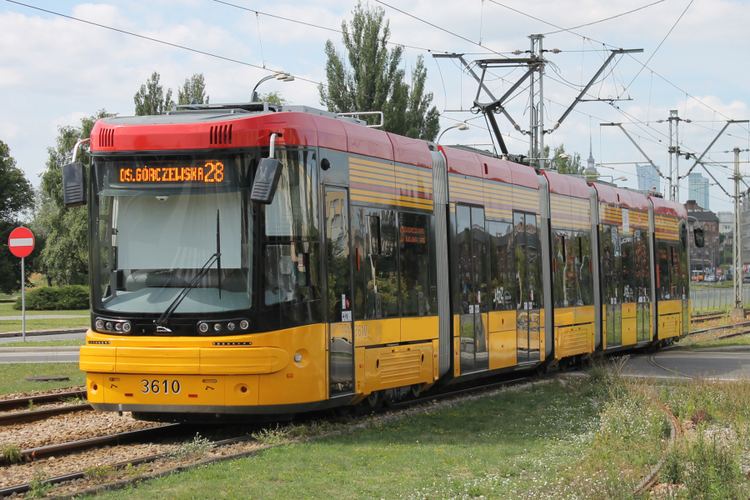Native name Tramwaje Warszawskie Transit type Tram Began operation 11 December 1866 | Number of lines 27 Operator(s) Tramwaje Warszawskie | |
 | ||
Trams in Warsaw (Polish: Tramwaje Warszawskie) is a 138-kilometre (86 mi) (276-kilometre (171 mi) of single track) tram system serving a third of Warsaw, Poland, and serving half the city's population. It operates over 750 cars, and is the second-largest system in the country (after the Silesian system) and one of the biggest in Europe. There are about 27 regular lines, forming a part of the city's integrated public transport system organized by the Warsaw Transport Authority. Since 1994 the system is operated by the municipal-owned company Tramwaje Warszawskie Sp. z.o.o.
Contents
Horse tram
The history of tram transport in Warsaw dates back to 1866 when a 6-kilometre (3.7 mi) long horsecar line was built to transport goods and passengers between the Vienna Railway Station and the Wilno and Terespol stations across the Vistula River. This was in order to circumvent limitations imposed by Russian authorities, which prevented the construction of a railway bridge for strategic reasons. In 1880, a second line was constructed with the help of Belgian capital, this time intended as public transit within the city. The Belgian company quickly expanded its own lines, and in 1882 took over the line between the railway stations, which has lost most of its original purpose after a railway bridge was finally built in 1875. In 1899 the entire tram system, by then 30 kilometres (19 mi) of tracks with 234 tram cars and 654 horses operating 17 lines, was purchased by the city. By 1903, plans were drafted to convert the system to electric trams, which was done by 1908.
Interbellum
The development mostly stagnated for the next 10 years with only a few short stretches built. After World War I, the network developed rapidly handling increased traffic and extending to the outskirts of the city with the network reaching the length of 60 kilometres (37 mi) and 757 tram cars in 1939. In 1927, a privately owned light rail line called EKD (today Warszawska Kolej Dojazdowa) was built, connecting several neighboring towns with the center of Warsaw using electric railcars similar to trams, only larger and more massive, with frequent stops and tracks running along the streets in city; however the system was incompatible with the Warsaw trams as it used standard gauge tracks while the city network still used broad gauge left from Russian times. In 1925, the company operating the Warsaw trams decided to construct a rapid transit system. Preliminary boring started, but the Warsaw Metro was postponed because of the Great Depression; the idea resurfaced in 1938, but was again buried with the outbreak of World War II.
Second half of the 20th century
The tram system remained operational, although gradually deteriorating, during most the Nazi occupation until the Warsaw Uprising in 1944, after which all the infrastructure was systematically destroyed. After the war it was rebuilt relatively fast. As the system was practically built from scratch the occasion was used to convert it to standard gauge. During the 1950s and 1960s, the network was extended to newly built districts of soviet style panel houses and industrial plants and newer trams based on the design of Presidents' Conference Committee were introduced. Due to the city's lack of a metro system and restriction on car ownership, the tram system remained the backbone of Warsaw's transport system. In the 1960s, however, a political decision was made to increase the dependency on oil imported from Russia, while Polish coal was to be exported to Western Europe in exchange for hard currency; as a result, newly developed districts were connected with the city center by buses rather than trams, and some of the existing tracks were closed.
Present situation
After 1989, the tram system in Warsaw initially received little investment with a large part of the city's budget spent on the construction of the first Warsaw Metro line. However, since 2005, the situation has been changing with the purchase of new rolling stock, modernization of key tram lines, and deployment of a passenger information system. Plans also include extension of the network and an "intelligent" traffic management system which is to prioritize trams at traffic lights. In August 2008, a tender for delivery of 186 low-floor, air-conditioned trams was launched, allowing for a dramatic overhaul of the look of the tramway system.
In 2014 a new line was open connecting a quickly growing remote residential district on the north eastern outskirts of the city with the existing tram network and the M1 metro line. The route is currently undergoing further expansion and is to be completed in the spring of 2017. As of November 2016, two more new lines are being planned: one to Gocław, and the other to a southern suburb of Wilanów; these should be completed in the years 2020-23.
Tickets
There is one ticket tariff for every mode of transportation. Tickets can be purchased at ticket machines at the station or on the tram.
Route list
This is a list of Warsaw Tramway lines. as of 2015, there were several track closures all over the tramway system, due to the construction of the second metro line. This list shows tram lines which are operating as of 10 March 2015 and the routes they operate on as of the same date. Instead of normal lines there are also tourist lines (line T) or horse tram in the Old Town.
